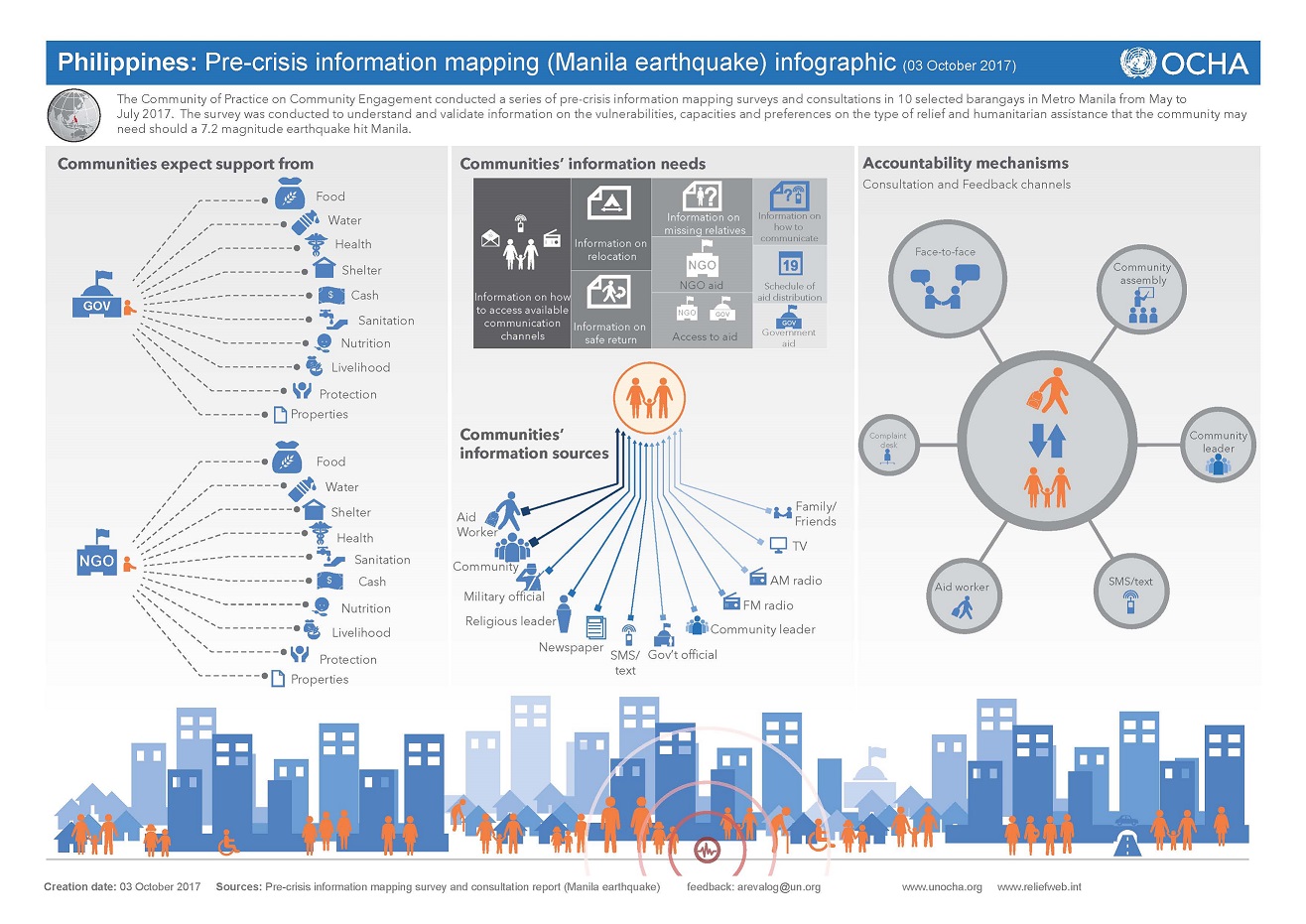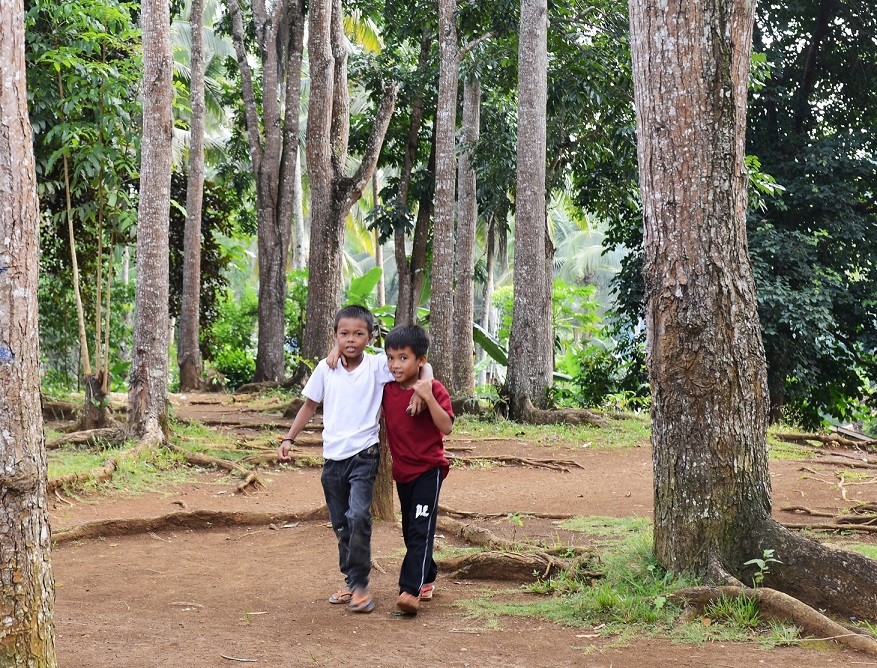
Sustaining humanitarian response in Marawi
The conflict continues in Marawi city, with displaced communities hoping that fighting will end soon so they can return home. Many are anxious about the condition of the home they left behind, with local reports showing extensive damage to properties and infrastructure in the business district. The Government is planning for the reconstruction of the city, with the Department of Budget and Management earmarking P15 billion (US$295 million) for the next two years.
Nearly 360,000 persons continue to live with host communities and crowded evacuation centres mainly in Lanao del Sur and Lanao del Norte provinces.Those in evacuation centres are in a protracted situation as local authorities, with support from the humanitarian community, look to meet their needs for the coming months focusing on: food, health, water supply and sanitation, shelter and psychosocial assistance. Meanwhile, internally displaced persons (IDPs) in host communities continue to experience inadequate assistance. There are reports of irregular food distribution, health services and poor water supply and sanitation.
Continuing needs in evacuation centres and host communities
Even before the conflict in Marawi city, most of the barangays in the municipalities now hosting displaced people were facing poverty and a lack of basic social services. With the added burden, most of the facilities are overwhelmed. Only four water trucks are delivering water to all the evacuation centres. The Department of Health, with support from partners are carrying out disease surveillance to monitor the incidence of skin diseases, acute respiratory infection, and diarrhoea, which remain the top diseases recorded at health units. It is not clear how many people with diarrhoea can access health facilities. The WASH cluster carried out an assessment in the eastern part of Lake Lanao in the third week of September. An evacuation centre in Buadipuso Butong was found to have only one latrine and no washing facility. In Bubong, 25 displaced families share one toilet with the local community, with similar challenges found elsewhere.
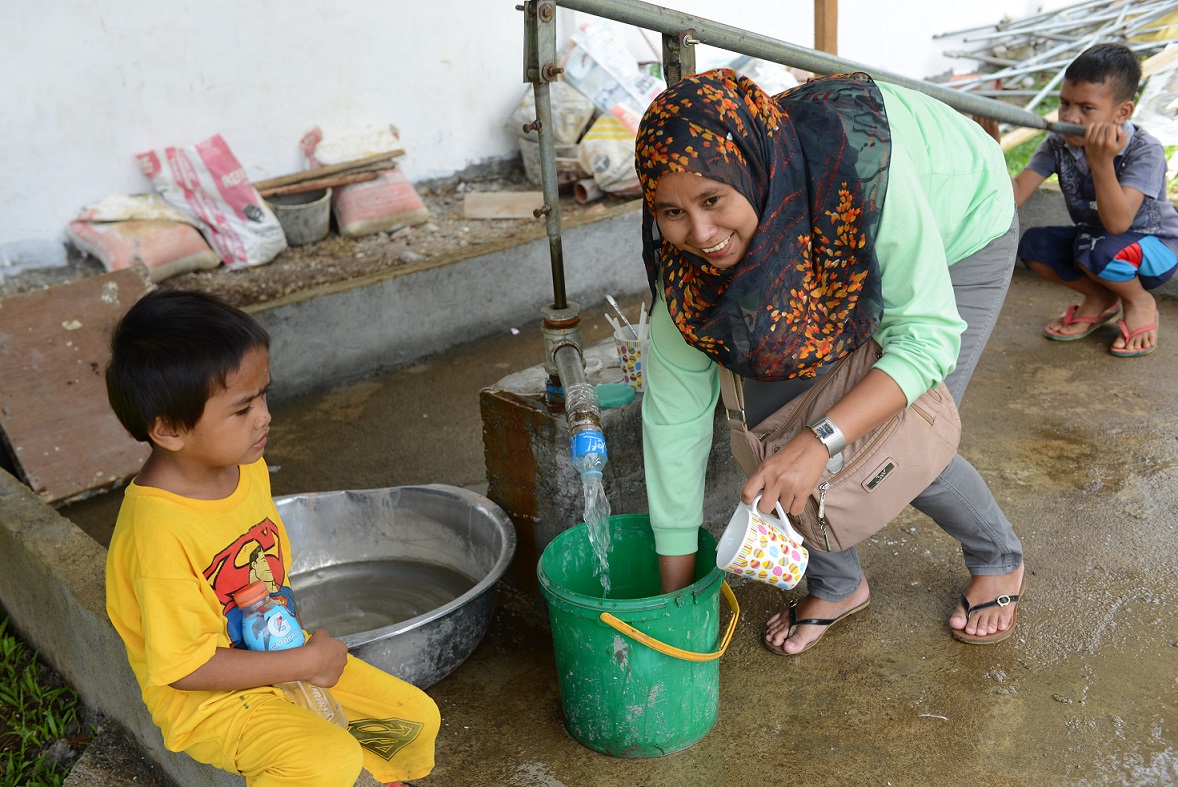
Credit: OCHA/G. Maramag Balo-i, Lanao del Norte (14 September 2017) - A women washes cups at a newly installed hand pump beside an evacuation centre in Barangay Pacalundo. The IDPs appreciate that new water facilities help them with other domestic duties such as washing dishes and watering their vegetable garden at their evacuation site.
In order to coordinate assistance for IDPs, the local governments of Lanao del Norte and Lanao del Sur are convening weekly meetings at Pantar, Baloi, Pantao-Ragat, and Saguiaran municipalities and they are encouraging agencies to coordinate all assistance for the IDPs with them.
The Government recognizes the importance of resolving land ownership and land entitlement issues in Marawi city. Feedback from IDP consultations indicate that a majority are worried about regaining their land and properties.
On 21 September, Executive Director of Task Force Bangon Marawi, Undersecretary Cesar Yano announced at a meeting with Marawi barangay captains that a new sub-committee on land resources management would respond to land issues. Meanwhile IDPs continue to call for a clear policy from the Government regarding compensation for families that will be affected by road widening and other projects planned for the reconstruction of Marawi.
Members of the Mindanao Humanitarian Team (MHT) continue to work with Government counterparts in responding to the needs of the IDPs. As of 14 September, around 116 agencies have completed more than 2,000 sectoral activities in the response. At an MHT workshop in Iligan City on 29 September, the members agreed that each sector will map out assistance that they can provide with currently available resources. The workshop allowed sectors to come together to have a dialogue on outstanding needs, priority actions and planned response of agencies from October to up to December this year.
Focusing on food security and livelihoods
The initial focus on health and WASH interventions has shifted slightly to food security and livelihood concerns. The Food and Agriculture Organization of the United Nations (FAO) continues to work closely with the Department of Agriculture and Fisheries of the Autonomous Region in Muslim Mindanao, the Department of Agrarian Reform and the Department of Agriculture to restore the food security and agricultural livelihoods of communities affected by the Marawi and Maguindanao crises. Rice, corn and vegetable seeds, fertilizer, farming tools and poultry-raising packages are currently being prepositioned for immediate distribution to at least 8,437 households in 15 municipalities/city in Lanao del Sur and Maguindanao. FAO has so far mobilized $800,000 in contributions from the Government of the Kingdom of Belgium through the FAO Special Fund for Emergency and Rehabilitation Activities, and the Government of New Zealand through an ongoing project in central Mindanao. FAO is seeking additional funding to cover the needs of the remaining unserved farming households.

Credit: OCHA/J. Rostrata Iligan City, Lanao del Norte (21 September 2017) - At a dialogue with barangay captains from Marawi City, Task Force Bangon Marawi and local authorities discuss land issues and other concerns of those displaced by the Marawi conflict.
Since the beginning of the Marawi conflict, the World Food Programme (WFP) has received US$2.7 million to provide food assistance to affected populations. WFP has assisted 9,000 IDP families in July, 7,500 IDP families in August and September, and is planning to assist 7,800 IDP families until December 2017. WFP, through the provision of rice, is supporting emergency school feeding for 52,000 students to assist the displaced students to continue their learning. WFP plans to raise this to 60,000 students until December 2017.
The Regional Government of the Autonomous Region in Muslim Mindanao has requested for WFP to extend its food assistance until December 2017, for which WFP has prepared another proposal for donor support to the amount of US$2.35 million. AMDF/Care, Ecoweb, Lanao Youth Council, Maranao People Development Inc. (MARADECA) and Samaritan’s Purse are also undertaking food support.
Initial results of the Protection Cluster's IDP intention and needs survey
Five UN agencies (IOM, OCHA, UNHCR, UNICEF, and WFP) together with twenty international and national non-governmental organizations deployed over 200 field enumerators from 21-28 August. Over 14,000 respondents displaced by the Marawi conflict in Cagayan de Oro, Iligan, Marawi and 30 municipalities on the east and west side of Lake Lanao were interviewed, representing over 18 per cent of displaced families registered with the Department of Social Welfare and Development.
The survey covered issues of protection, livelihood, in-kind assistance, movement, and information and communication. It revealed that 91 per cent of the displaced people depend on aid and that key concerns of IDPs were decreasing quality and quantity of food aid and limited livelihood opportunities. Four per cent of the IDP respondents knew about the Government’s rehabilitation programme, although 66 per cent said they were not consulted.
On land ownership, 60 per cent own their houses in Marawi, though fewer than a third of these respondents have land titles as proof of ownership. If their houses were damaged, cash tops the list of assistance that will be needed followed by materials.
Majority of the respondents depend on relief assistance (91 per cent), while 20 per cent depend on remittances from abroad, 18 per cent from Government’s 4Ps program, and others took a loan from the bank or relatives. On issue of return, most of the respondents (94 per cent) want to return to Marawi. Those who did not want to return cited security as the main reason, followed by their ability to stay with relatives, and their fear that they would not have access to basic services and livelihoods.
As of 14 September, around 116 agencies have completed more than 2,000 sectoral activities in the response.
Ninety-one per cent of displaced people depend on aid and that key concerns of IDPs were decreasing quality and quantity of food aid and limited livelihood opportunities.
A midpoint update of emergency response fund activities in Marawi
In July, the Humanitarian Country Team saw the need to alleviate life-threatening conditions related to water-borne and communicable diseases endured by a target group of 58,700 people displaced by the Marawi conflict. A grant from the United Nations Central Response Emergency Fund (CERF) was allocated to support humanitarian rapid response activities related to these conditions. The funding, in the amount of nearly $2.5 million, is being utilized in rapid response activities that focus on protection, health, water, sanitation and health by five recipient agencies: IOM, UNFPA, UNHCR, UNICEF and WHO, together with local implementing partners.
For a critical four month period, the agencies are jointly targeting displaced persons in Balo-i, Pantao Ragat, and Pantar municipalities in Lanao del Norte and Saguiaran in Lanao del Sur. In September, the agencies gave an update on their mid-point progress.
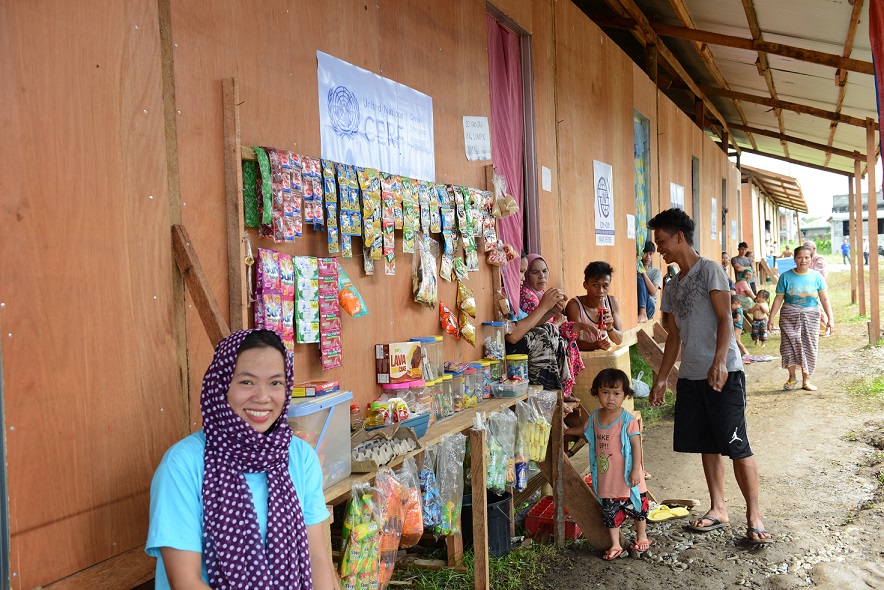
Camp coordination and camp management
IOM’s activities include the use of a Displacement Tracking Matrix (DTM) to gather information on displaced persons in evacuation centres. As of September, forty out of 73 evacuation centres have been reached so far.
IOM is also providing CCCM training support and camp management kits to help deploy trained camp managers. IDP participation was also organized in evacuation centres to give them the opportunity to express their urgent needs and concerns. Key concerns raised by the IDPs were the need for information on their return to Marawi, reparation for damaged properties, and opportunities for livelihood assistance. IOM is working with their local implementing partners, Mindanao State University – Iligan Institute of Technology (MSU-IIT), Maranao People Development Center (MARADECA), and Ecosystems Work for Essential Benefits (ECOWEB). In evacuation centres, IOM is upgrading facilities, providing family privacy partitions and building alternative living spaces.
Health
WHO, together with its implementing partner, the Mindanao Organization for Social and Economic Progress (MOSEP) have so far reached 90 out of 93 target barangays in the four municipalities. They have served over 10,000 patients through 131 medical visits, an average of 78 patients per visit. WHO is also monitoring cases of watery diarrhoea and gastroenteritis on a weekly basis, which have decreased over time. According to government reports, cases of cholera have not increased.
UNFPA is conducting medical health missions, benefiting from relief items prepositioned by Australia’s Department of Foreign Affairs and Trade. They continue to ensure access to reproductive health services to the vulnerable displaced population, providing women-friendly spaces and services targeted towards pregnant and lactating women, young girls and boys. They have also deployed a gender-based violence and sexual and gender-based violence prevention programme coordinator. Reproductive health missions are currently ongoing in CERF supported sites that will continue for the next two months. Implementing partner Community and Family Services International conducts outreach missions to schools that have taken in IDP children, focusing on boys and girls between 10-19 years old.
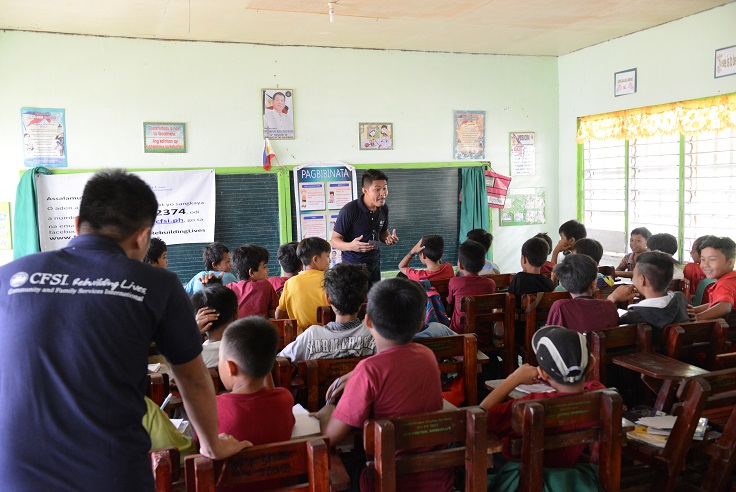
Water, sanitation and hygiene (WASH)
UNICEF’s activities of providing training on water quality monitoring, distributing water testing kits, constructing communal toilets with handwashing facilities, providing toilet construction kits , training on toilet construction, hygiene and sanitation promotion are ongoing. Temporary sludge treatment facilities were constructed in Balo-i and Tagoloan.
Partners Action Against Hunger and the Humanitarian Response Consortium’s A Single Drop for Safe Water are conducting hygiene promotion and community consultations on toilet construction. Displaced persons attend community meetings to provide valuable input. In Barangay Pacalundo, Balo-i, IDPs gave suggestions to improve the initial design, such as to space the male and female facilities further apart. They also voiced their appreciation that the toilets were not facing Qibla, the direction Muslims face when at prayer. They also indicated that the newly constructed hand pump was useful for other domestic uses such as washing dishes and gardening.
Protection
Improving access to rights and protection for IDPs was key output for a protection-centric response. The registration of IDPs, important in ensuring access to rights and freedom of movement, were completed in partnership with the Department of Social Welfare and Development.
To address the restriction of freedom of movement among the IDPs which impacts their ability to integrate and establish their livelihood, UNHCR has initiated a project with Philhealth together with Government agencies and local authorities to issue identification cards to member and non-qualified member IDPs. The project will be completed by the first week of November.
UNHCR and its implementing partner, Community and Family Services International continue to provide protection information campaigns and distribute core relief items that will help improve living conditions for not only IDPs but also their host families. Protection monitoring and reporting activities in the four target municipalities have been regularly conducted. A total of 256 home-based IDPs identified with extreme vulnerability were provided with specialized assistance during the first round of relief distribution. Assessment is also ongoing to identify IDPs in community-based evacuation centres who will be targeted for the provision of assistance. Distribution will be completed by the end of November.
Sharing challenges and lessons learned
Recipient agencies and their partners shared collective challenges that come with implementing rapid response activities. The primary concern was humanitarian access. Field visits were sometimes postponed due to the volatile security situation, or roads were being repaired or conditions were not safe for travel. Serving home-based IDPs was also a challenge, as only those in evacuation centres were being catered by rural health units. Land issues, local procurement and political dynamics were also cited. There are needs in municipalities well beyond those covered by the project. As access improves, additional resources are needed to expand assistance to those outside the scope of the CERF project.
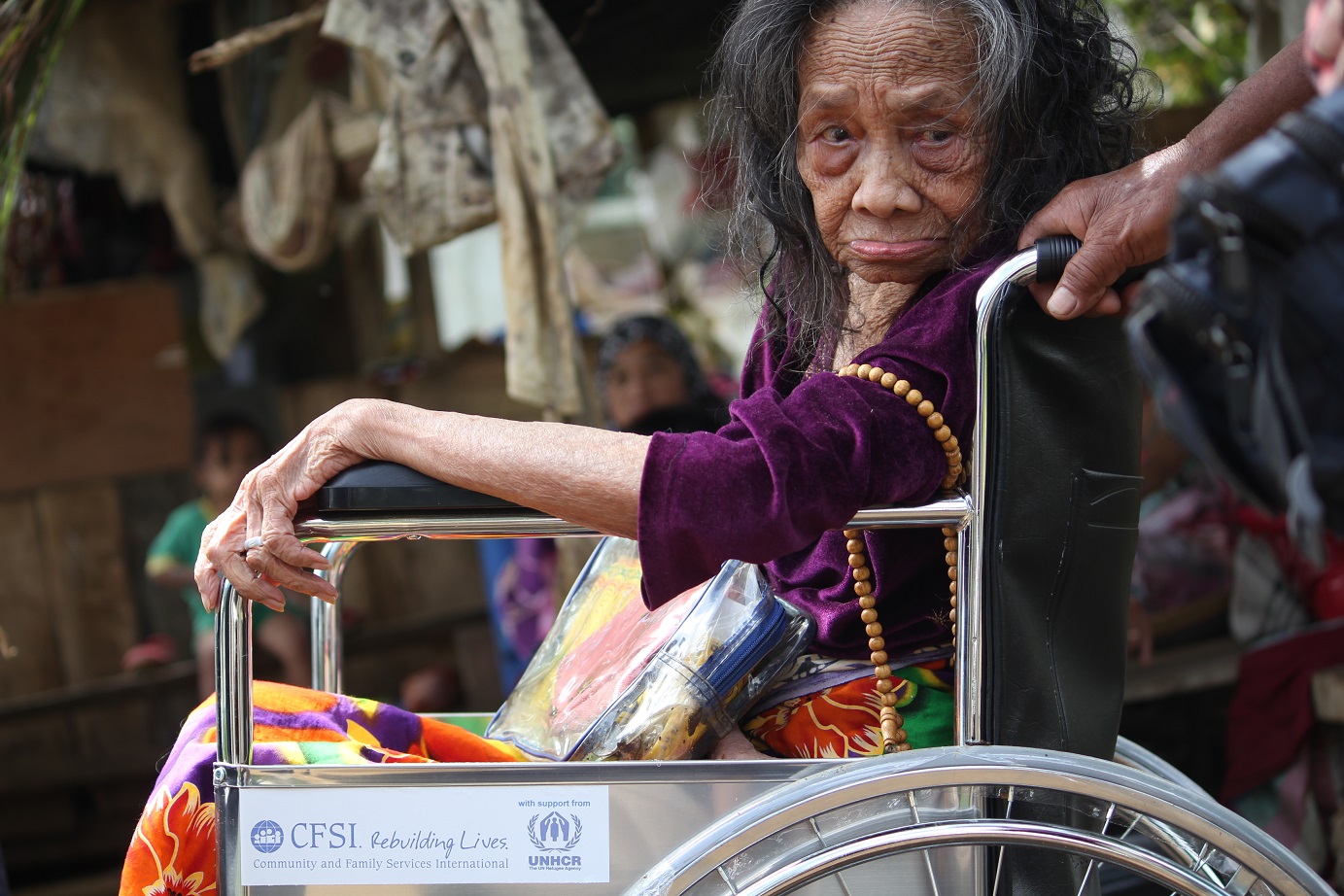
Key concerns raised by the IDPs were the need for information on their return to Marawi, reparation for damaged properties, and opportunities for livelihood assistance.
256 home-based IDPs identified with extreme vulnerability were provided with specialized assistance during the first round of relief distribution.
Response preparedness for medium-scale typhoon emergencies
The Humanitarian Country Team (HCT) developed in 2016 a contingency plan to prepare the in-country international humanitarian community to respond and support government in the event of a catastrophic category-5 typhoon (more than 252 km/ hr winds). However, recent experience points to a more likely scenario of a mediumscale natural disaster in which government takes the lead in response, with limited and targeted international assistance utilizing in-country resources.
The Philippine Atmospheric, Geophysical and Astronomical Services Administration (PAGASA) indicated that five to eight tropical cyclones may affect the Philippine Area of Responsibility from September 2017 to February 2018. Tropical cyclone activities during this period also coincide with the peak of the southwest monsoon (Habagat) season which could enhance weather systems and bring heavy rains and strong winds. During the past few years, the country has experienced category 3 typhoons (up to 224 km/h winds) particularly during the latter part of the year – such as typhoons Koppu (October 2015), Melor (December 2015), Haima (October 2016) and Nock-ten (December 2016) – which resulted in casualties and displacements of population, disruption of basic services, and damage to properties.
With this in mind, the Inter-Cluster Coordination Group/Emergency Response Preparedness Working Group (ICCG/ERPWG) held a workshop on 25 September to discuss cluster and sector key responsibilities and coordination principles, challenges and solutions for engaging the government in small- and medium-scale disasters, asset and capacity mapping, and development of an emergency response and preparedness plan, including a pro-forma resource mobilization document.
Several of the outcomes from the workshop will be tagged as key priority activities for the typhoon season, including the continuing engagement/consultation with government in preparedness and response, and familiarizing each other with the coordination structure at the sectoral and sub-regional levels; and development of framework for the conduct of joint and coordinated rapid needs assessment for HCT member agencies.
Priority activities for the typhoon season include continuous engagement and consultation with government in preparedness and response.
Consulting communities before the "big one": Pre-crisis info mapping survey results released
As part of the earthquake contingency planning for Metro Manila, the Humanitarian Country Team’s Community of Practice on Community Engagement published a pre-crisis information mapping survey and consultation report. The results validate information on the vulnerabilities, capacities and preferences on the type of relief and humanitarian assistance that the community may need once a 7.2 magnitude earthquake hits Metro Manila. Complementing the earthquake preparedness initiatives by the local government, at-risk communities and other non-government organizations, the mapping survey and consultation analyse the actual needs of the most vulnerable, marginalized, less visible and less vocal members of the at-risk communities. These include persons with disabilities, elderly, women and children. The pre-crisis information mapping survey and consultation was conducted in 10 selected barangays from May to July 2017 and covered the cities of Quezon, Valenzuela, Marikina, Pasig, Malabon and Manila.
